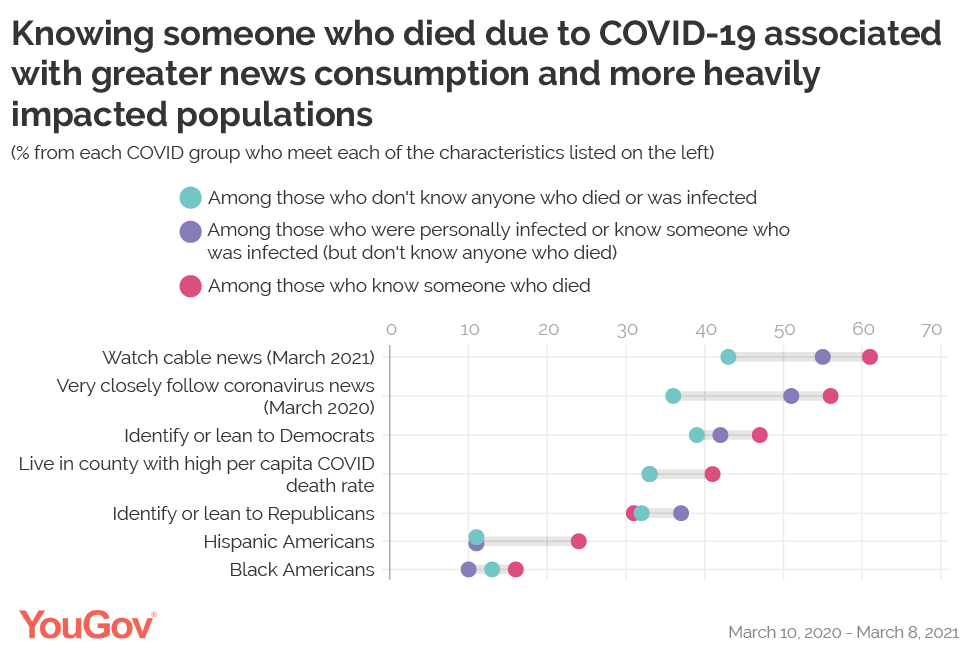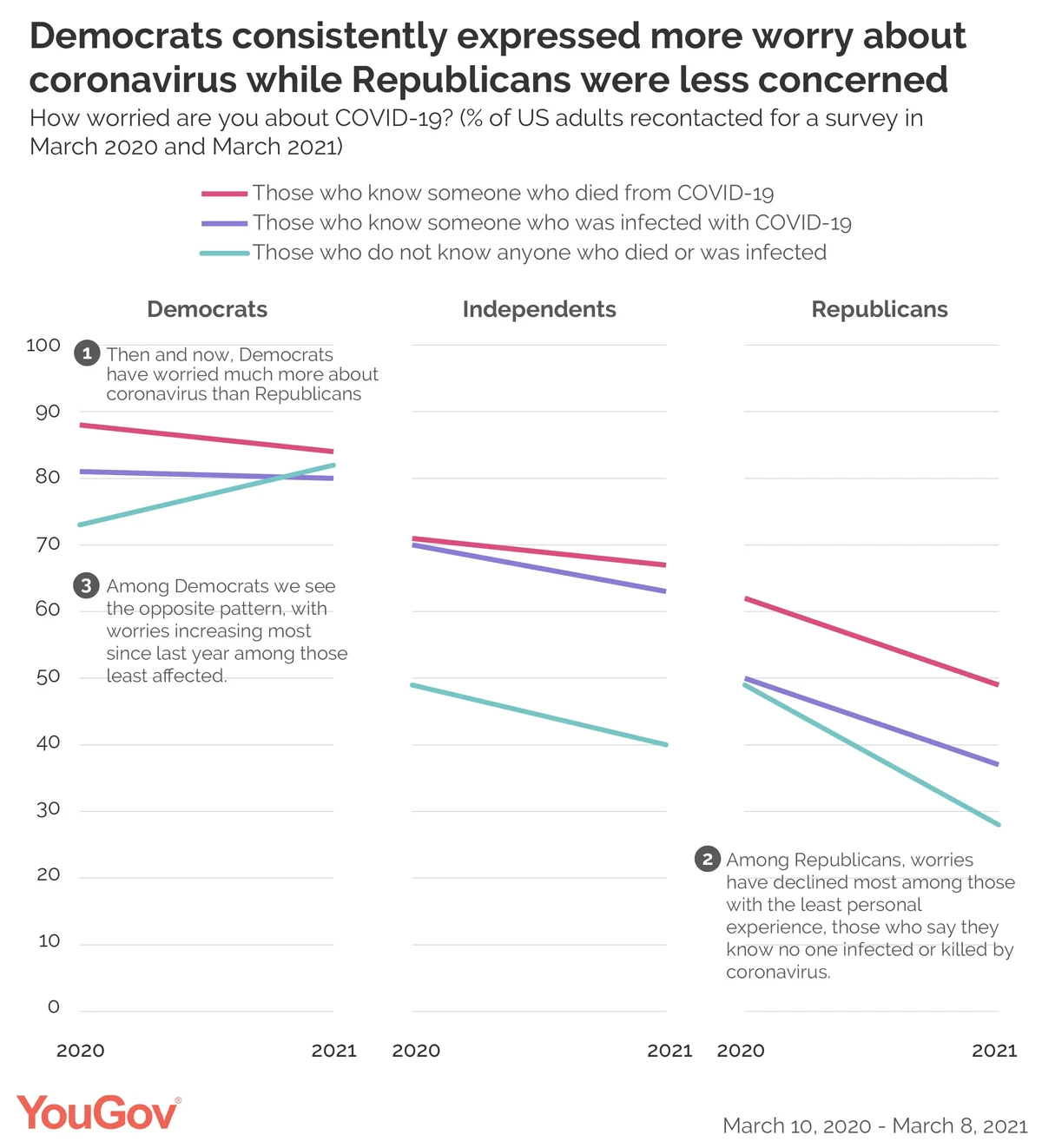Few events have impacted the everyday lives of ordinary Americans as much as the COVID-19 pandemic. As of March 16, according to the Centers for Disease Control, the virus has infected over 29 million in the U.S. and killed over 533,000. The most recent Yahoo News/YouGov poll finds that nearly two-thirds of American adults (64%) have either been infected themselves or have family members or close friends who have been infected, and more than a quarter (28%) report that family members or close friends have died due to complications from the virus.
How much have these personal experiences shaped opinions related to COVID-19? The answer that emerges from recent YouGov’s recent polling is surprisingly complex: for some, knowing someone infected or killed by COVID-19 helped confirm early worries obtained from news accounts. For others, the lack of personal experience allowed the partisan political environment to play a larger role.
To illustrate the potential impact of personal experience with the coronavirus, we divided respondents into three groups: (1) those who report a family member or close friend died due to complications from COVID-19 (28% of all adults), (2) others who, while not knowing anyone who died, were either personally infected with COVID-19 or reported a close friend or family member who was infected (37%), and (3) those who reported neither a close friend or family member who died from or been infected with COVID-19 (30%). Excluded from this analysis are 5% who prefer not to say whether friends or family had been infected or killed by the virus.
At first glance, personal experiences appear to have considerable impact on current attitudes. For example, more than two-thirds (69%) of those who know someone who died are still very or somewhat worried about COVID-19, compared to 61% of those who know someone infected but not anyone who died, and 52% of those who say they know no one who died or was infected.
This pattern persists for other COVID-19 attitudes, including vaccine acceptance, perceptions of whether the threat has been exaggerated and whether other Americans are underestimating coronavirus risks, concerns about lifting restrictions too quickly, whether mask wearing should be mandatory, and so on. In every case, those who report a family member or close friend died due complications of coronavirus are the most convinced of the severity of COVID-19 and the most supportive of measures to control its spread.
Given the consistent pattern, it is tempting to interpret these differences as caused by the experience of being infected or having a friend or family member infected or killed by the virus. But we can test that proposition more directly, since this particular Yahoo/YouGov survey recontacted adults originally interviewed for two coronavirus tracking surveys conducted a year ago, in March 2020. How much did individual opinions change?
The results are somewhat surprising. Consider general worries about coronavirus. Although better than 99% of the COVID-19 infections and deaths have occurred since our surveys in March 2020 (according to CDC statistics), those who report knowing someone who was infected or who died on our most recent survey were already more worried about coronavirus a year ago. While worries among all adults are modestly lower now (61%) than a year ago (67%), the differences between the subgroups are nearly identical to those a year ago. Those who report knowing someone who died or was infected are consistently higher than those without such personal experiences.
Solving this riddle requires looking more closely at which respondents changed their opinions, because in this case, the similar declines among the subgroups are a little misleading. Something very different happened at the individual level.
Those who had the most painful personal experience – the death of a close friend or loved one – were much more likely to remain worried about coronavirus on the recent follow-up survey (61%) than those who knew someone infected but not anyone who died (52%) and those who knew no one infected or killed by the virus (39%). Meanwhile those least affected personally – those who say they knew no one infected or killed – were consistently less worried about COVID-19 over the year (28%) or more likely to have shifted in either direction over the course of the year (33%) than other respondents.
What explains the relative stability of those most affected and the greater shifts among those who reported less personal experience with COVID-19?
First, for those who knew someone that died, personal experience likely helped harden their first impressions and confirm their early fears. Those with no such contact were more open to the sway of partisanship and the larger political environment, in which Democrats consistently expressed more worry about coronavirus and Republicans less. The change-over-time data confirm this: Among Republicans, worries declined most among those with the least personal experience, while among Democrats we see the opposite pattern, worries increasing only among the least affected, but generally consistent among the rest. Second, consider why those who ultimately had greater personal experience with coronavirus were more worried about it from the start. Some people may have been better at anticipating the risk levels that people they knew – perhaps people with pre-existing health conditions, essential workers, Black or Hispanic Americans or people otherwise more vulnerable – and worried more about it.  The data show that those who knew someone who died as a result of coronavirus were different in two ways that support this theory. First, they were bigger news consumers. Those who knew someone who died due to COVID-19 are far more likely to say they followed news about coronavirus (56%) or watched cable news (61%) than those who say they knew no one infected or killed (36% and 43% respectively). They were also more likely to be members of populations that suffered greater coronavirus mortality: Hispanic (24%), Black (16%) or living in a county with a high per-capita COVID-19 death rate (41%).
The data show that those who knew someone who died as a result of coronavirus were different in two ways that support this theory. First, they were bigger news consumers. Those who knew someone who died due to COVID-19 are far more likely to say they followed news about coronavirus (56%) or watched cable news (61%) than those who say they knew no one infected or killed (36% and 43% respectively). They were also more likely to be members of populations that suffered greater coronavirus mortality: Hispanic (24%), Black (16%) or living in a county with a high per-capita COVID-19 death rate (41%).

In other words, if you were someone who closely followed news coverage in March 2020, which emphasized the early disparate impact in urban areas and among Black and Hispanic populations – you were probably better able to anticipate if the virus posed a greater risk to you, your family and close friends.
It is also worth considering that for some, partisan attitudes may have affected their willingness to report knowing someone who died or was infected. President Trump embraced theories that downplayed the role of COVID-19 in deaths attributed to the virus, and some pundits claimed that only a small fraction of COVID-19 deaths could actually be attributed to the virus. In our recent survey, those who said they knew no one who died due to coronavirus were more likely to question death counts (33% said fewer people died than the 500,000+ reported by the government) than those who knew someone who died (27%). So perhaps some of our respondents were less willing to report that a family member or friend died for the same reasons.
Either way, there is no question that personal experience contributed to American’s opinions on the coronavirus pandemic, though as with the virus itself, some were more profoundly affected than others.
See the toplines and crosstabs from the most recent Yahoo News/YouGov poll, as well as the March 2020 data
Methodology: The Yahoo! News survey was conducted by YouGov using a nationally representative sample of 1,629 U.S. adults interviewed online between March 4-8, 2021. The respondents all participated in a prior Yahoo! News survey conducted either March 10-11, 2020, or March 25-26, 2020 and were contacted to participate. Of the 3,214 adults who participated in either of the two March 2020 surveys, 1,629 responded to this survey – a recontact rate of 50.7%. This sample was weighted according to gender, age, race, and education based on the American Community Survey, conducted by the U.S. Bureau of the Census, as well as 2020 Presidential vote (or non-vote), and voter registration status. Respondents were selected from YouGov’s opt-in panel to be representative of all U.S. adults. The margin of error for the entire sample is 2.9%.
This report includes a reference to respondents living in counties with a high COVID-19 death rate. These were counties in the top third of per-capita covid death rates, as calculated using population data from the U.S. Census and COVID-19 data compiled by The New York Times based on reports from state and local health agencies.
Image: Getty











